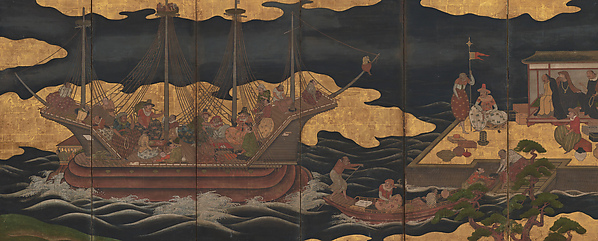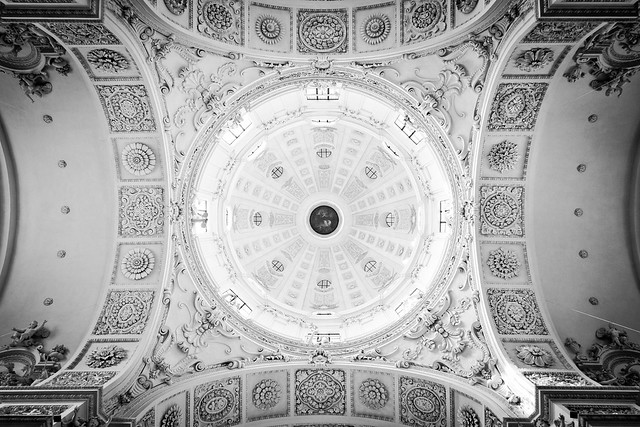An exhibition
entitled The Flowering of Edo Period Painting is currently on at The Metropolitan Museum of Art in New York City
and will run until the seventh of September this year. Spread over two
centuries between the early 1500s and 1868, and marked by rule of the Tokugawa
Shogunate over the Japanese islands, the Edo period is seen to have opened up a
period of political stability that allowed for a variety of arts and crafts to
be systematically developed. The exhibition at the Metropolitan Museum was
built around a number of screens, scrolls and other paintings from this long
period.
Located among
the many artworks from this period, is a rather large Namban screen. While the term Namban
is often associated with Japanese arts forms associated with the Portuguese
expansion from fifteenth century it is worth going into the origin of the term
to elaborate the point I seek to make. A Sino-Japanese word Namban was the term used for South
Asians and South-East Asians and translated to Southern barbarians. At around
the time of the Portuguese expansion into Asia, given that the Portuguese were
emerging into Japanese waters and territory from their locations in South Asia,
primarily but not exclusively Goa, the term came to be used for the Portuguese
as well. Indeed, Namban screens
profusely depict Portuguese in their distinctive baggy trousers and hats,
arriving in ships, with their slaves, promenading under umbrellas and engaged
in trade.
What struck me
about this particular screen, however, was the presence of figures that within
the Namban norms of depiction looked
distinctly non-Portuguese. The caption accompanying the screen read: ‘In 1543,
a storm blew a Portuguese ship onto the tiny Japanese island of Tanegashima,
and within a year, Portuguese ships began making regular visits to ports In
Kyushu. The Japanese called them Namban,
“Southern Barbarians,” since they were arriving from India via a southern
route. A widespread frenzy of curiosity developed about these strange new
arrivals in their giant ships with booming cannons, their mustaches curling
beneath their noses, the dark skins of the Goanese sailors, and their exotic
clothing.’
Always the Goan first, the caption excited my imagination. Here, far away in America I was viewing sixteenth century Japanese representations of my Goan kinsmen. This excitement was not, however, without some amount of irritation. “Why Goanese? Do they not know that we prefer being called Goan?”
This annoyance was temporary, given that the preference for Goan over Goanese was largely that of the Goan elites who lived in the city of Bombay in the nineteenth centuries. Seeking to distinguish themselves from the Goanese who were their countrymen in labouring professions, they used Goan instead. Continuing to contemplate the caption and the screen itself, I realised that the audience was being presented with dramatic possibilities to reimagine Goan-ness.
To begin with, the caption indicated that the Portuguese were known not via their location in Europe, but their location in South Asia. They were received in Japan through the same epithet reserved for South and South East Asians. If in later times Portugal asserted a European identity for the citizens of the Estado da India, then in earlier times, their own European identity was, at least temporarily, displaced in favour of a South Asian one. Indeed, delving into the life histories of the Luso-descendentes will reveal to us how so many of them did and continue to think of South Asia, and Goa, not as a ‘colony’ but home. If we have failed to recognise the ambiguity of their identities and self-definitions thus far it is largely because our perspectives have been coloured and blinded by a worldview that grew out of the context of British imperialism.

At this moment, however, I am less concerned with the Portuguese than with what this caption and the screen do for the Goan. The image of the Goanese on that screen is not one that many of us would identify with today. If one is thinking of the Goan Catholic, then one is used to images of persons in European dress. For non-Catholic Goans, one is used to images of upper-caste Hindu men in dhotis, shirts and jackets. The Goanese depicted on the screen are at odds with this image. The most dominant one is turbaned, in a flowing gown, and counting the beads of what looks like a tasbih, or Islamic rosary.
This image is fortuitous because it allows us to draw the largely marginalised Muslim into our image of Goan-ness into two very different ways. To begin with it, in a context where the various Muslim communities in Goa have been excluded from our post-colonial imagination just as the Luso-descendentes and metropolitan Portuguese, the screen asserts that the Muslim is very much central to the Goan identity.
There are other turbaned figures featured on the screen, and yet others who while not in ‘oriental’ garb but dressed like Portuguese are represented somewhat differently, largely through the colouration of their skin. There is one particular individual on this screen that particularly caught the eye. Situated below the clearly Portuguese man (identified through his cap) and the Muslim, this person is a somewhat dark skinned man otherwise dressed in Portuguese garb. Could this be a native Catholic resident in the Estado da Índia? Or is this a representation of an African in the employ or enslavement of the merchant company?

One would need to be much more familiar with the iconography of Namban art to answer these questions. For now, however, the screen allows us to complicate the histories that produce a simplistic genealogy for the question of who is Goan. It excludes the variety of slaves, African and Japanese, who were brought into Goa, and who, no doubt, mixed with locals to produce contemporary Goans.
These exclusions have occurred largely through the dismemberment of the territories that constituted the former Estado da Índia. When Goa received statehood, it was premised on making Konkani the sole official language of the state. This necessitated the excision of the largely Gujarati (and Portuguese) speaking territories of Daman and Diu. In doing so, Goa was constructed as a provincial location that was the home of Konkani speakers alone. And yet, as the namban screen highlights, Goa has been more than a small provincial location, but an international and imperial (sub) centre. It gave identity to groups of persons larger than those who could claim a mythical tie to the land.
The privileging of Konkani was premised on securing the interests of Goan identity, in particular its minority groups, like the Catholics. But history has demonstrated that this route was a red herring. Goan Catholics are treated as second class citizens as the forms of Konkani that they use are excluded from the official definition of the language. Crafting Konkani as central to Goan identity also rested on imagining Goa as a space of village communities. This confounded the claims of Muslims as being authentically Goan, and also undermines the claims of persons outside of the caste groups that dominated the village communities. Further, it obscures the role of the Gujarati merchants, Muslim and Hindu, who have associated with Goa for generations, as well as occluding their role in crafting a Goan economy that is not tied to agriculture. This history also impoverishes the histories of thousands of regular Goans who have no obsession with claiming a pure blood line to Aryan groups by ignoring the multiple groups that were found their way into the Estado.

What the imagination of Goa as a Konkani alone space has done is to allow for this territory to be imagined in Hindutva compatible terms. A return to earlier imaginations of what Goa was, and who Goans are, would, perhaps undo some of the multiple exclusions that have marked post-colonial Goan politics and lay the foundation for a more dynamic society.
A version of this post was first published in the O Heraldo dated 27 June 2014.







